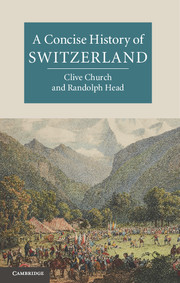Book contents
- Frontmatter
- Contents
- List of Illustrations
- List of Figures
- List of Maps
- Acknowledgements
- List of Abbreviations
- Introduction Making the Swiss
- 1 Before Switzerland
- 2 Creating the Swiss Confederacy, 1386–1520
- 3 A divided Switzerland in Reformation Europe, 1515–1713
- 4 The Ancien Régime, 1713–1798
- 5 Revolution and contention, 1798–1848
- 6 Forging the new nation, 1848–1914
- 7 The shocks of war, 1914–1950
- 8 The Sonderfall years, 1950–1990
- 9 Since 1989
- Chronology
- Glossary
- Further Reading
- Index
3 - A divided Switzerland in Reformation Europe, 1515–1713
Published online by Cambridge University Press: 05 June 2013
- Frontmatter
- Contents
- List of Illustrations
- List of Figures
- List of Maps
- Acknowledgements
- List of Abbreviations
- Introduction Making the Swiss
- 1 Before Switzerland
- 2 Creating the Swiss Confederacy, 1386–1520
- 3 A divided Switzerland in Reformation Europe, 1515–1713
- 4 The Ancien Régime, 1713–1798
- 5 Revolution and contention, 1798–1848
- 6 Forging the new nation, 1848–1914
- 7 The shocks of war, 1914–1950
- 8 The Sonderfall years, 1950–1990
- 9 Since 1989
- Chronology
- Glossary
- Further Reading
- Index
Summary
A dense web of political ties bound the Swiss Confederacy together by 1500. The Confederacy’s emergence paralleled developments across Europe, which was increasingly dominated by coherent states – in the west, the new monarchies of Spain, France and England, and in the band from the Netherlands to Italy, a combination of sizeable princely states and a few important republics, including Venice, the Swiss Confederacy, and eventually the Dutch Republic. The trajectory of Swiss development took unexpected directions in the early sixteenth century, however, because of Swiss troops’ declining potency and even more because of the Protestant Reformation and the resulting schism, which bitterly divided the Confederacy. Indeed, the Confederacy became an important centre for the development and spread of Protestant ideas with the preaching and church leadership of Ulrich Zwingli (1484–1531) and Heinrich Bullinger (1504–75) in Zurich, together with Jean Calvin (1509–64) in Geneva. In addition, the Anabaptist movement, predecessor of the modern Mennonite and Amish as well as many other community-based sectarian churches, had some of its earliest origins in Switzerland. Religious schism deeply divided the cantons, and brought institutional developments to a halt. Despite division, ironically, the national myths of the Swiss continued to evolve into the 1570s, and became widely disseminated.
The Thirty Years War (1618–48) was a cataclysmic struggle that devastated much of the Holy Roman Empire – but not Switzerland. Rather, despite internal religious division, the Confederacy remained neutral, although the associated Grisons were drawn into the war and suffered in consequence. At the end of the war, the overheated economy’s decline, exacerbated by a corruptly executed devaluation of the coinage, triggered a massive peasant revolt in the midlands. The Swiss Peasants’ War of 1653 briefly united peasants from across the Confederacy, whose ‘parliament’ unsuccessfully demanded a permanent voice in Swiss politics.
- Type
- Chapter
- Information
- A Concise History of Switzerland , pp. 73 - 103Publisher: Cambridge University PressPrint publication year: 2013



